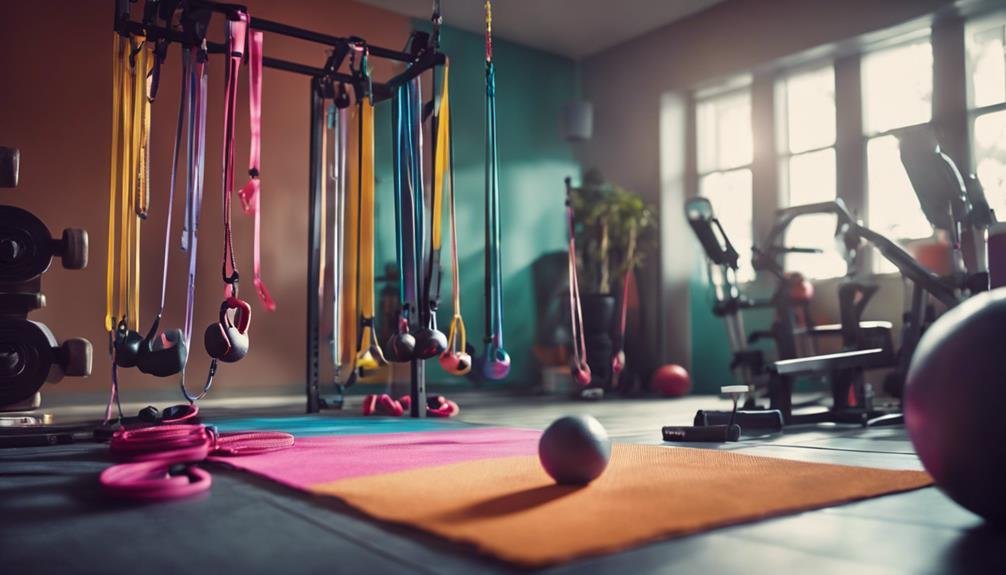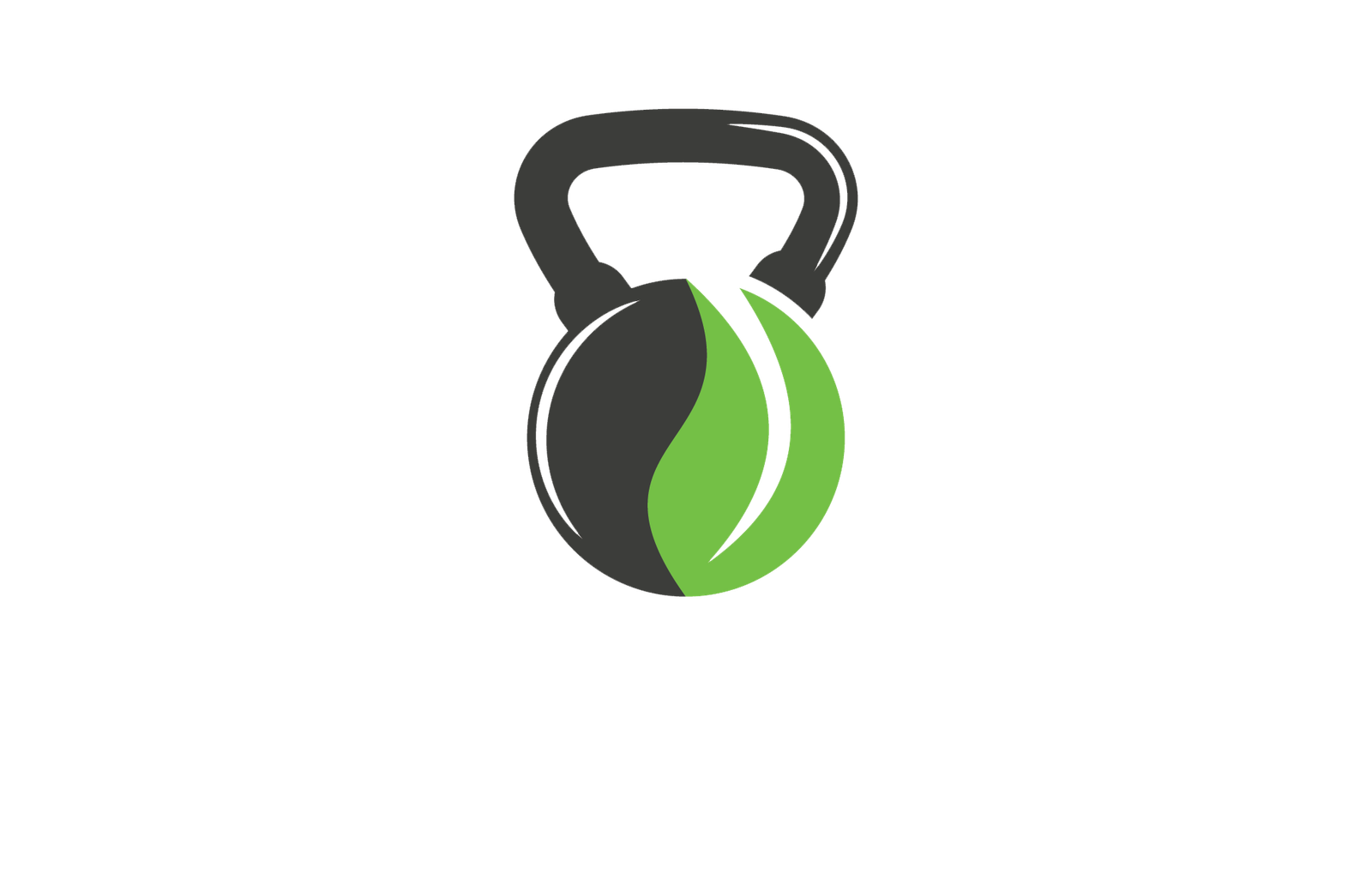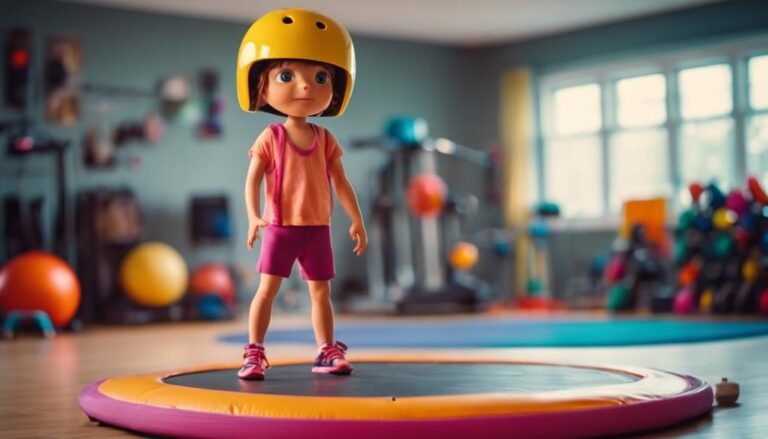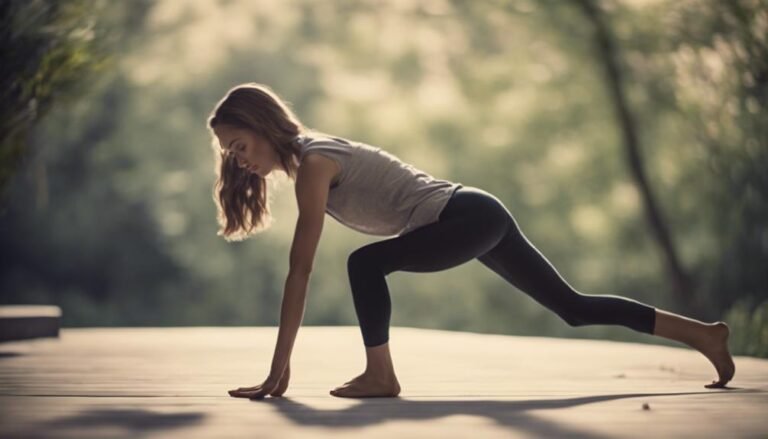Don't miss our holiday offer - 20% OFF!

Functional Training Exercises for Home Fitness
Nurturing overall fitness and athleticism at home is just a few functional exercises away, but which ones will yield the most impressive results?
We're opting for functional training exercises at home because they offer a convenient and effective way to improve our overall fitness, increase strength, and boost athleticism, all while requiring minimal equipment and space. By incorporating exercises like squats, push-ups, and lunges into our daily routine, we can improve our posture, balance, and overall mobility. We'll learn how to engage our core, build strength, and boost our metabolism, all from the comfort of our own homes. Now, let's dive deeper into the world of functional training and discover the full potential of our at-home fitness journey.
Key Takeaways
- Incorporate bodyweight exercises like squats, push-ups, and lunges into your daily routine to build strength and improve overall fitness.
- Functional training exercises that target everyday movements, such as single-leg squats and heel-to-toe walks, can be done at home with minimal space and equipment.
- Core engagement is key to maintaining good posture and preventing injuries, and exercises like bicycle crunches and Russian twists can be done at home to target the entire core.
- Incorporating balance drills and coordination exercises, such as lateral hops and box jumps, into your workout routine can improve overall fitness and reduce the risk of injury.
- Consistency and patience are key to achieving functional fitness, and incorporating exercises into your daily routine can improve overall fitness and well-being.
Building Core Strength at Home
As we explore building core strength at home, let's start with the basics: a strong core is essential for good posture, balance, and overall athletic performance, and can be achieved with a few simple exercises that require minimal equipment. We'll focus on exercises that engage our core muscles, improving our overall stability and balance. Core engagement is key to maintaining good posture and preventing injuries.
We'll start with exercises that target our transverse abdominis muscle, which wraps around our spine and pelvis, providing pelvic stability. This muscle is essential for maintaining good posture, balance, and overall athletic performance. By strengthening our core, we'll improve our overall athletic performance and reduce our risk of injury. With a few simple exercises, we can build a strong core at home, improving our overall fitness and well-being. We'll explore exercises that require minimal equipment, making it easy to get started. By incorporating these exercises into our daily routine, we'll be on our way to building a strong, stable core that will benefit our overall fitness and athletic performance.
Squats for Everyday Mobility
As we move on to squats for everyday mobility, we're excited to explore how this essential exercise can benefit our daily lives. We'll discover how squats can help us build stronger legs, which in turn, will improve our overall mobility and balance. By incorporating squats into our routine, we'll be able to tackle everyday tasks with more ease and confidence.
Building Stronger Legs
We rely on our legs to carry us through daily life, from climbing stairs to playing with our kids, and strong legs are essential for everyday mobility and independence. As we age, our leg strength can decline, making everyday activities more challenging. That's why it's vital to prioritize building stronger legs through functional training exercises.
Squats are a great place to start, as they work multiple leg muscles simultaneously. But we shouldn't stop there. To target our legs from different angles, we can incorporate exercises like the Leg Press, which focuses on our quadriceps, hamstrings, and glutes. Additionally, Calf Raises are essential for strong ankles and calves, allowing us to maintain balance and stability.
Improving Posture Alignment
By strengthening our legs through exercises like squats, we can improve our posture alignment, which is essential for maintaining good balance and reducing the risk of injuries in our daily activities. When we have strong legs, we're better able to support our body weight, which in turn helps us maintain proper posture. This is especially important when we're sitting, as it can help us avoid slouching and putting unnecessary strain on our backs.
| Proper Sitting Tips | Benefits |
|---|---|
| Keep feet flat on floor or on a footrest | Reduces strain on lower back |
| Keep knees at or below hip level | Maintains spinal extension |
| Adjust chair height to support natural curve of spine | Improves posture alignment |
Functional Fitness for Beginners
As we start our functional fitness journey, we'll focus on getting started easily, without feeling overwhelmed. We'll explore basic exercise routines that target everyday movements, making it relatable and achievable. By building core strength, we'll establish a solid foundation for more advanced exercises and real-life activities.
Getting Started Easily
When we're new to functional fitness, we must begin with exercises that work multiple muscle groups at once, helping us build overall strength and endurance efficiently. This approach sets us up for success on our fitness journey, allowing us to create a well-rounded workout routine that we can stick to.
To get started, we don't need a lot of space or equipment. We can use our home space to our advantage, finding exercises that work for us, not against us. Here are three easy exercises to get us started:
- Bodyweight squats: Strengthen our legs and glutes with this simple, effective exercise.
- Push-ups: Work our chests, shoulders, and triceps with this classic exercise.
- Lunges: Target our legs, glutes, and core with this easy-to-modify exercise.
With these exercises, we can fit a great workout into even the busiest schedule. By starting small and being consistent, we'll be on our way to achieving our fitness goals in no time. Remember, every small step counts, and every workout is a step in the right direction.
Basic Exercise Routines
We'll focus on building a solid foundation with basic exercise routines that work multiple muscle groups at once, maximizing our results and minimizing our workout time. As beginners, we must start with exercises that engage our entire body, improving overall fitness and setting us up for success. Let's begin with a Morning Stretch routine to get our blood flowing and muscles warm. Simple exercises like leg swings, arm circles, and torso twists will loosen us up and prepare us for a day of activity.
In the evening, we'll follow an Evening Routine that targets major muscle groups. Squats, lunges, and push-ups are excellent exercises that work multiple muscles simultaneously, saving us time and energy. We'll aim to do 3 sets of 10-12 reps for each exercise, resting for 60-90 seconds between sets. Remember to listen to our bodies and only do what feels comfortable and safe. As we progress, we can always increase intensity and difficulty. For now, let's focus on building a strong foundation and celebrating small victories along the way. With consistency and patience, we'll be on our way to achieving functional fitness in no time!
Building Core Strength
By targeting our core muscles, we can substantially improve our overall functional fitness, enhancing our balance, stability, and overall athletic performance. This is because our core serves as the foundation of our body, providing the stability and support needed for efficient movement and peak athletic performance. By building strong core muscles, we can improve our core stabilization, which is essential for everyday activities and sports.
Three exercises to help us build core strength are:
- Plank: Hold a plank position for 30-60 seconds, rest for 30 seconds, and repeat for 3-5 sets. This exercise targets our abs, obliques, and lower back muscles.
- Russian twists: Lie on our back with knees bent and feet flat on the floor, twist our torso to left and right, touching hands to the ground each time. Do 3 sets of 15-20 reps.
- Leg raises: Lie on our back with arms extended overhead and raise our legs straight up towards the ceiling, then lower them back down without touching the floor. Do 3 sets of 15-20 reps.
Bodyweight Exercises for Strength
We can build incredible strength without any equipment, using our own body weight as resistance to challenge and transform our bodies. Bodyweight exercises are a great way to improve muscle tone and build power, and the best part is that we can do them anywhere, anytime. We don't need to spend hours at the gym or invest in expensive equipment – our own bodies are all we need.
We can start with simple exercises like push-ups, squats, and lunges, which work multiple muscle groups at once. These exercises help us build functional strength that translates to everyday life, making it easier to carry groceries, play with our kids, or simply get up from the couch. As we progress, we can add more challenging exercises like pull-ups, dips, and single-leg squats to continue pushing ourselves. By incorporating bodyweight exercises into our routine, we'll be amazed at how quickly we can build strength, boost our confidence, and take our fitness to the next level.
Improving Balance and Coordination
Functional training exercises that challenge our balance and coordination are essential for building overall athleticism and reducing our risk of injury, as they teach our bodies to react and adapt to changing environments and movements. By incorporating balance drills and coordination exercises into our workout routine, we can improve our overall fitness and reduce our risk of injury.
Here are three exercises to get us started:
- Single-Leg Squats: Stand on one leg, keeping the other foot lifted off the ground. Slowly lower ourselves into a squat, then push back up to the starting position. Repeat on the other leg.
- Heel-To-Toe Walks: Walk along a straight line, placing the heel of one foot directly in front of the toes of the other foot. This exercise challenges our balance and coordination, improving our overall athleticism.
- Lateral Hops: Stand with our feet shoulder-width apart. Hop sideways to one side, landing on the balls of our feet. Quickly hop back to the starting position. Repeat on the other side.
Effective Exercises for Weight Loss
As we focus on effective exercises for weight loss, we're excited to share with you the most impactful ones that will help us achieve our goals. We'll explore the best exercises to burn belly fat fast, boost our metabolism rate, and shed pounds quickly. By incorporating these exercises into our routine, we'll be on our way to achieving a leaner, healthier body.
Burn Belly Fat Fast
You can torch belly fat quickly and efficiently with the right combination of exercises that target your core and boost your metabolism. We're not talking about hours on the treadmill or tedious crunches; we're talking about effective, fat-burning exercises that deliver quick results.
To get a flat stomach, we need to focus on exercises that target our entire core, including our obliques and lower back. Here are our top picks for burning belly fat fast:
- Bicycle Crunches: This exercise targets the entire core, including the obliques, and gets your heart rate up for maximum fat burning.
- Russian twists: This exercise specifically targets the obliques, helping to burn fat and create definition in the midsection.
- Burpees: This full-body exercise gets your heart rate up and burns calories fast, making it an effective way to burn belly fat.
Boost Metabolism Rate
By incorporating exercises that boost our metabolism, we can supercharge our weight loss efforts and burn belly fat even faster. This is especially important for those of us who want to see results quickly. To get started, we can try incorporating fat-burning exercises into our morning routines. For example, we can start with a 10-minute HIIT (High-Intensity Interval Training) session, followed by some strength training exercises that target our core and legs. This will not only get our hearts pumping but also engage our largest muscle groups to burn maximum calories. By doing so, we'll be able to boost our resting metabolic rate, meaning our bodies will continue to burn fat even when we're not actively exercising. Additionally, we can incorporate exercises that target our slow-twitch muscle fibers, which are responsible for burning fat for energy. By incorporating these exercises into our daily routine, we'll be well on our way to boosting our metabolism and achieving our weight loss goals.
Shed Pounds Quickly
We're about to turbocharge our weight loss journey with a series of effective exercises specifically designed to shed pounds quickly and efficiently. By incorporating these exercises into our daily routine, we'll be on our way to a rapid transformation that will leave us feeling confident and energized.
Here are three essential exercises to get us started:
- Burpees: A full-body exercise that combines strength training and cardio to torch calories and fat.
- Mountain Climbers: A high-intensity exercise that targets our core, legs, and arms, while getting our heart rate up and burning calories fast.
- Jump Squats: A powerful exercise that works our legs, glutes, and core, while boosting our metabolism and energy levels.
Functional Training for Athletes
As athletes, we require a training regimen that not only enhances our physical abilities but also improves our performance in our respective sports. Functional training is an essential component of our fitness routine, as it helps us to develop the strength, agility, and endurance needed to excel in our chosen sport.
By incorporating functional exercises into our workout routine, we can improve our speed, power, and overall athleticism. This, in turn, enables us to perform at a higher level, giving us a competitive edge over our opponents. Additionally, functional training helps us to prevent injuries, which is vital in maintaining our physical fitness and staying at the top of our game.
Moreover, as athletes, it is clear to us that sports nutrition plays a vital role in fuelling our bodies for peak performance. By combining functional training with a well-planned diet, we can maximize our energy levels and accelerate our recovery. In addition, functional training promotes team dynamics, as it encourages us to work together, communicate effectively, and rely on each other to achieve a common goal. By adopting a functional training approach, we can tap into our full potential and take our athletic performance to the next level.
Simple Exercises for Back Pain
Performing simple exercises can help alleviate back pain, which affects millions of people worldwide, and we're taking the first step towards a stronger, healthier back by incorporating these functional training exercises into our daily routine. By doing so, we can reduce the discomfort and stiffness associated with back pain, and improve our overall quality of life.
Here are three simple exercises to get us started:
- Knee to Chest Stretch: Lie on our back, bring one knee towards our chest, and hold for 30 seconds. This gentle stretching exercise helps to decompress the spine and relieve pressure on our back muscles.
- Cat-Cow Stretch: Start on our hands and knees. Arch our back, lifting our tailbone and head towards the ceiling (like a cat). Then, round our back, tucking our chin to our chest and our tailbone towards the floor (like a cow). Repeat for 10-15 repetitions, promoting spinal decompression and flexibility.
- Pelvic Tilt: Lie on our back with our knees bent and feet flat on the floor. Tilt our pelvis upwards and then back down again, repeating the motion for 10-15 repetitions. This exercise helps to strengthen our core and improve our posture, reducing strain on our back.
Enhancing Flexibility at Home
By incorporating flexibility exercises into our daily routine, we can improve our range of motion, reduce stiffness, and enhance overall flexibility from the comfort of our own homes. As we age, our flexibility naturally declines, but with consistent practice, we can maintain and even improve our flexibility. We can start with simple stretching routines, focusing on major muscle groups like hamstrings, quadriceps, and hip flexors. Foam rolling is another effective way to release tension and improve circulation. To take it to the next level, we can incorporate yoga poses that target specific areas, like downward-facing dog for hamstring flexibility. Muscle relaxation techniques, such as deep breathing and progressive muscle relaxation, can also help reduce muscle tension. Regular flexibility tests can help us track our progress and identify areas for improvement. By prioritizing flexibility exercises, we can prevent injuries and maintain peak physical function. By making flexibility a priority, we can enjoy a more active, pain-free life.
Plyometric Exercises for Power
We can explosively boost our power and speed with plyometric exercises, which involve rapid, high-intensity movements that engage our muscles in a unique way. These exercises are designed to generate a power surge, allowing us to jump higher, run faster, and react quicker. By incorporating plyometric exercises into our workout routine, we can experience a significant improvement in our overall athletic performance.
Here are three plyometric exercises to get us started:
- Box Jumps: Jump onto a box or bench, then step down and repeat. This exercise targets our legs and glutes, helping us develop explosive power.
- Depth Jumps: Jump from a box or bench, then immediately jump up as high as possible. This exercise improves our ability to absorb force and explosively jump high.
- Burpees: A full-body exercise that involves a squat, push-up, and jump. Burpees are an excellent way to improve our power, strength, and endurance.
Functional Workout for Busy Days
When our schedules get hectic, it's easy to let workouts fall by the wayside, but incorporating functional exercises into our daily routine can be a game-changer for staying on track, even on the busiest of days. By prioritizing our morning routines, we can squeeze in a quick and effective workout that sets us up for success. Effective time management is key; we can't let our busy schedules dictate our fitness goals. Instead, we can wake up 30 minutes earlier and fit in a functional workout that targets multiple muscle groups at once. This will not only boost our energy levels but also increase our productivity throughout the day. For example, we can start with bodyweight exercises like squats, lunges, and push-ups, followed by some plyometric moves like jump squats and box jumps. By incorporating functional exercises into our morning routine, we can stay consistent with our fitness goals, even on the most chaotic of days.
Building Strength With Resistance
Now that we've established a routine, let's crank up the intensity by incorporating resistance exercises that target specific muscle groups, challenging ourselves to build strength and endurance. We're talking serious muscle tension here! It's time to take our fitness journey to the next level.
To do this, we'll be using resistance bands, which are lightweight, portable, and easy to use. The best part? They work multiple muscle groups at once, saving us time and maximizing our results.
Here are three exercises to get us started:
- Banded Squats: Loop a resistance band around a stable object, then perform a squat, keeping the band taut. This works our legs, glutes, and core.
- Banded Chest Press: Hold a resistance band in both hands, then press it away from our body, extending our arms fully. This targets our chest, shoulders, and triceps.
- Banded Rows: Anchor a resistance band to a stable object, then hold the ends of the band in each hand. Keeping our elbows close to our body, pull the band toward our chest, squeezing our shoulder blades together. This targets our back, shoulders, and biceps.
Everyday Activities Made Easier
As we go about our daily lives, we often take for granted the simple tasks that make up our daily routines. However, with functional training exercises, we can make these tasks easier and less exhausting, allowing us to tackle daily chores, simple household tasks, and maintain our independent living skills with confidence and energy. By incorporating these exercises into our fitness regimen, we can take control of our daily lives and make everyday activities a whole lot easier.
Daily Chores Made Easy
By incorporating functional training exercises into our daily routines, we can build the strength and agility needed to tackle everyday tasks with greater ease and efficiency. This means we can manage our time more effectively, getting more done in less time, and having more energy to enjoy the things we love.
Here are just a few examples of how functional training can make daily chores easier:
- Laundry day: We can lift, carry, and bend with ease, making quick work of sorting, washing, and folding.
- Meal prep: We can chop, stir, and cook with confidence, whipping up healthy meals in no time.
- Household organization: We can lift, move, and arrange with precision, keeping our living spaces tidy and clutter-free.
Simple Household Tasks
We can tackle simple household tasks, like taking out the trash, feeding pets, and watering plants, with greater efficiency and energy when we've got functional training under our belt. By incorporating exercises that target our core, legs, and upper body, we can take on these daily tasks with confidence. For instance, doing laundry exercises like squats and lunges can help us lift heavy baskets with ease. Meanwhile, kitchen stretches like shoulder rolls and wrist extensions can reduce fatigue while cooking or washing dishes. By incorporating functional training into our fitness routine, we can make quick work of these mundane tasks and have more energy to spare. We'll be able to tackle that never-ending to-do list with enthusiasm, rather than exhaustion. By building strength, endurance, and flexibility, we can turn chores into a breeze, freeing up time for the things we love. With functional training, we can take control of our daily lives and make every task a little easier.
Independent Living Skills
Mastering independent living skills, such as personal grooming and managing our finances, becomes second nature when we incorporate functional training exercises into our daily routine. By focusing on exercises that improve our strength, balance, and coordination, we can make everyday activities easier and more manageable. This means we can maintain our independence and confidence in our daily lives.
Here are just a few examples of how functional training exercises can impact our daily routines:
- Morning routines: We can get out of bed and start our day with more energy and enthusiasm, thanks to exercises that improve our mobility and flexibility.
- Self-care habits: By incorporating exercises that target our upper body, we can make tasks like brushing our teeth, washing our hair, and even cooking meals easier and less straining.
- Money management: With improved dexterity and fine motor skills, we can confidently manage our finances, write checks, and balance our checkbooks without struggle.
Full Body Functional Exercises
Incorporating full body functional exercises into our workout routine can be a game-changer, as they simultaneously engage multiple joints and muscle groups, mimicking real-life movements and boosting overall fitness. As we age, our functional age, or the age our body behaves as, can be profoundly impacted by our ability to perform daily tasks with ease. By incorporating full body functional exercises, we can maintain or even improve our functional age, allowing us to live life to the fullest. Dynamic movement exercises, such as squats, lunges, and step-ups, are excellent examples of full body functional exercises that challenge our coordination, balance, and strength. These exercises prepare our bodies for real-life situations, like carrying groceries or playing with our kids, making everyday tasks feel less intimidating. By incorporating these exercises into our routine, we can improve our overall fitness, increase our energy levels, and enhance our independence. We'll be able to tackle daily tasks with confidence, knowing our bodies are capable of handling whatever life throws our way.
No-Equipment Home Workout Routines
By ditching the gym membership and opting for no-equipment home workout routines, you can still achieve a killer workout in the comfort of your own space. We're not saying it's easy, but with the right mindset and a dash of home motivation, we can get fit without breaking the bank or waiting in line for equipment.
Here are three no-equipment exercises to get us started:
- Burpees: A full-body exercise that works our arms, legs, and core. We'll be doing a lot of these!
- Mountain climbers: A high-intensity exercise that targets our legs and gets our heart rate up. We'll be doing sets of 30 seconds to start.
- Plank hold: A core-strengthening exercise that'll have us engaging our abs and improving our posture. Aim for a 30-second hold to start.
With these exercises, we can create a killer no-equipment home workout routine that'll have us sweating and smiling in no time. And the best part? We can do it with our workout buddies, cheering each other on from the comfort of our own homes. So, who's ready to get started?
Frequently Asked Questions
Can I Do Functional Training Exercises With a Prior Injury?
"We understand concerns about exercising with prior injuries. We can modify exercises to accommodate our limitations, taking precautionary measures to avoid exacerbating the issue, and still achieve our fitness goals."
How Long Does It Take to See Results From Functional Training?
We typically start seeing results from functional training in 4-6 weeks, but it's essential we track our progress and stay consistent – that's where the real magic happens, and we'll be motivated to keep pushing forward!
Can I Mix Functional Training With Traditional Weightlifting?
We can definitely mix functional training with traditional weightlifting, but we must be mindful of potential muscle imbalances. By incorporating exercise variations, we can create a well-rounded routine that targets all muscle groups, ensuring a balanced fitness journey.
Are Functional Training Exercises Suitable for Seniors?
"As we age, our golden years become a delicate balance, like autumn leaves clinging to their branches. Fortunately, functional training exercises can be a lifeline for seniors, improving mobility and preventing devastating falls, empowering them to live life to the fullest."
Do I Need a Large Space for Functional Training Exercises?
"We don't need a sprawling gym to get fit; we can overcome space constraints with compact workouts that deliver big results in small spaces, proving functional training exercises are accessible to everyone, anywhere."
Conclusion
As we wrap up our journey through functional training exercises for home fitness, remember that every small step counts. Did you know that just 10-15 minutes of exercise per day can increase your life expectancy by 3-5 years? That's a significant return on investment! By incorporating these exercises into your daily routine, you'll be on your way to improved mobility, strength, and balance. So, get moving and make every day a healthier, happier one!



